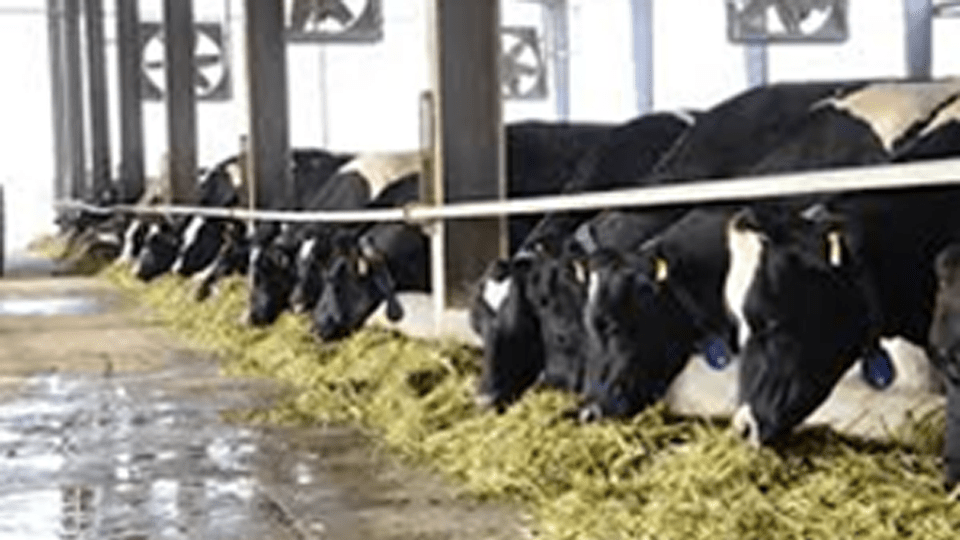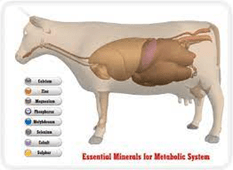
Preamble:
Minerals are important for all physiological processes in animals including production and reproduction. Nine trace minerals are considered essential for dairy cows are- Zinc (Zn) Cobalt (Co), Copper (Cu), Iodine (I), Iron (Fe), Manganese (Mn), Chromium (Cr), Molybdenum (Mo) and Selenium (Se). Adequate trace mineral status is important in dairy cow, calf and replacement heifer because their vital role in reproduction, immunity and growth. Research has suggested that slight deficiencies of certain trace minerals may severely affect a cow’s health and productivity. Subclinical deficiencies are more common than clinical deficiencies that results in decreased immune response, reduce growth and reproductive performance. Clinical deficiencies are less common and can be seen in animals depleted of trace minerals demonstrating pathological or visual signs of a deficiency.
Trace minerals in Dairy Animals:
Adequate amount of bioavailable minerals need to be supplemented to support the aemostatic state of the animal during all phases of life. During periods of dietary mineral insufficiencies, essential minerals drained out from body tissues to support milk production, which ultimately affects the quality and quantity of milk as well as health of the animals. Reduction in pregnancy rates can occur as a subclinical effect of marginal trace mineral status. Deficiencies in Cu, Se, Mn, and Zn have been linked to abnormal estrous cycles, impaired ovulation and decreased conception rates.
In development of replacement heifers, trace minerals Cu, Se, Mn, Cr and Zn play roles in bodily functions that support reproduction. Supplementations of trace minerals improve conception rate & productivity in dairy cows in different situations.
Zinc (Zn):
Numerous studies have indicated that zinc may be the most widely deficient trace mineral. A component of more than 300 enzymes and hormones, zinc plays an important role in metabolism. In particular, protein biosynthesis and the regulation of gene activity can be affected by zinc. Zinc may impact immune function because of its essential role in cell replication and proliferation. Zinc is also required for the synthesis of metallothionein, a metal binding protein that may scavenge hydroxide radicals. Due to its crucial function in defence enzymes, zinc deficiency reduces disease resistance. In dairy cows, zinc deficiency is visible through bad hoof horn quality, reduced fertility and poor udder health. Zinc-deficient calves may have swollen feet, scally skin with open lesions, wounds that take longer to heal, loss of hair, excessive salivation, reduced appetite, reduced feed efficiency and growth rates, and impaired immune systems. Many animals require supplemental Zn for normal body function because of either low levels in the dietary ingredients or the presence of antagonistic factors which decrease the bioavailability of the element.
Manganese (Mn):
is mainly stored in the bone, liver, kidney and pancreas. It works as an enzyme activator and is crucial for energy-, protein- and fat metabolism. Manganese’s importance in steroid hormone synthesis may be its most important role in reproduction. It is suggested that Mn plays an important role within the ovary in hormone synthesis where it stimulates cholesterol synthesis which indirectly influences steroid hormone synthesis. It is also hypothesized that Mn may play an important role in immune function because of its role in removing superoxide radicals produced by active immune cells. Deficiencies in manganese are reflected in reduced growth, skeletal deformities, poor fertility and birth defects in new born calves.
Copper (Cu):
Copper requirements of cattle are based on their needs for growth and reproduction. In the body, Cu plays important roles in the formation of haemoglobin, bone, melanin and keratin. Cu is also an essential component of enzymes that have activities in cellular respiration, cross-linking of connective tissue, central nervous system formation, reproduction and immunity. In the reproductive cycle, Cu plays an important role in the function of many enzymes. A clinical deficiency in copper can lead to decreased conception rates, infertility, anoestrus, and fetal resorption. Cu is also important to the antioxidant system because it is part of the copper-zinc superoxide dismutase enzyme. This enzyme helps convert superoxide radicals to hydrogen peroxide in the cell. Cu deficiency can occur in diets normally considered adequate because of high levels of antagonists such as sulfur, iron, and molybdenum which reduce bioavailability.
Chromium (Cr):
Chromium has been shown to be effective in increasing glucose use and growth performance. Cr increases effectiveness of insulin action in lactating ruminants which has an overall increase in metabolic efficiency, leading to improved production. Cr supplementation also improves health and immune function in stressed calves & cows. Results indicated that supplemental Cr reduce adipose lipolysis, and increase nutrient intake and milk production. It is reported that cows receiving chromium in the last 9 weeks of pregnancy have reduced incidence of retained placentas as compared to un-supplemented cows.
Selenium (Se):
Selenium performs a number of functions in the body. Both selenium and vitamin E act as metabolic anti-oxidants. Selenium is a major constituent of glutathione peroxidase, which aids in the reduction of hydrogen peroxide and other peroxide radicals. Selenium acts directly on granulosa cells of ovarian follicle to enhance their proliferation and increase estradiol synthesis. Se deficiency resulted in reduced follicle cell proliferation, altered blood vessel and stromal tissue development of the fetal ovaries. Selenium plays a role in the final stages of parturition, though the exact mechanism remains unclear. Moreover, Se is readily transferred to the fetus through the placental barrier at the expense of the cow. During the third trimester, the fetus increases in weight and length exponentially, which can cause impacts on maternal Se status. A reduction in maternal Se status could lead to reduced antioxidant production and activity. Therefore, additional supplementation of Se during the third trimester may be needed to maintain maternal Se status and antioxidant activity.
Factors affecting trace mineral status:
Sufficient amount of trace minerals determine the reproductive performance, growth & development of young animals and immune status of animals. The absorption of essential trace minerals from feed or feed supplements is often not sufficient when the demand for these minerals is high.
A variety of factors negatively impact the absorption of orally consumed trace minerals. These can include poor or inadequate trace mineral supplementation strategies, large variations in oral mineral intake and the presence of antagonists in feed & forages. This reduced absorption or bio-availability makes it difficult to optimize trace mineral status and functions at critical production periods using only the oral intake route.
It is reported that dairy cows and calves under stress reduced their trace mineral retention ability. Moreover, either the act of parturition or the beginning of lactation has been found to be related with a decrease in plasma minerals levels. Hence, during the transition period cows may have increased trace minerals needs that a diet formulated to meet the NRC recommendations for dairy cows may not satisfy, especially since dietary mineral supplements may not be absorbed properly due to interactions with other nutrients at the ruminal level or due to modifications in the rumen. Besides, antagonists located in drinking water may also have a negative effect on the efficiency of trace minerals absorption from the digestive tract. As for example, dietary sulfur seems to reduce the bioavailability of Se and Cu; high dietary iron reduces Cu bioavailability. Additionally, high dietary Ca and phosphorus may reduce Mn absorption in ruminants.
Immunity and Trace Minerals
Research suggested the role of zinc, iron, copper, and selenium in disease resistance of dairy animals. It is reported that complex antioxidant systems keep free radical concentrations low through superoxide mutases (need Mn, Zn, and Cu), catalase (Fe containing enzyme), and glutathione peroxidase (Se containing enzyme). These enzymes are water soluble and protect components within the cytosol (cell soluble). With zinc deficiency, thymus weight is reduced with a reduced number of lymphocytes. The thymus is important in T cell formation and immune capacity. Young animals may be more affected because they are not as immune-competent as mature animals. Zinc supplemented animals had improved gain and reduced treatment day in stressed cattle. Zinc serum levels were found significantly higher in healthy calves compared to sick calves when challenged with bovine respiratory disease. Iron deficiencies affect antibody formation associated with B cells. Copper affects the antibody forming cells of the immune system and susceptibility to infection. Trace minerals effects on immunity have been established, but specific levels have not been documented.
Injectable Trace minerals:
The technology, targeted application, and scientific assessment of efficacy of Injectable trace minerals has been a subject of attention in the recent years. Copper, Se, Mn, Cr and Zn are the trace minerals that can be supplemented through injection. It is basically designed for administration in conjunction with a pre-existing dietary mineral program so as to ensure a consistent rate of trace mineral supplementation on a per animal basis. Trace mineral injections can also be utilized to treat animals with a suspected mineral deficiency.

Conclusion:
Trace mineral supplementation in the diet of dairy cow, replacement heifers & calves is essential to maintain the health and the economic competitiveness of the dairy farmers. Many dynamic factors influence both nutrient requirements and nutrient availability from feeds. With the genetic improvement of the herd, mineral supplementation and their bioavailability have become more complex and are influenced by a variety of factors, including bioavailability in ration, trace mineral interactions, stage of production and even breed. While daily oral trace minerals are essential for maintenance but at critical periods like pre-calving, calving and early-lactation daily oral trace mineral intake can become variable or fall in response to stress. During these periods there is a marked increase trace mineral demand. Clinical or subclinical deficiency can develop in cattle at these high demand periods, even a well formulated diet may not compensate. Strategic injectable trace mineral supplementation bypasses the harsh rumen environment and antagonists, rapidly raises circulating mineral levels in cattle within eight-to-ten hours. Injectable formulation of most essential trace minerals comprise of Zinc, Manganese, Copper, Selenium etc. may be ideal solution for Cows during the period of high productivity & developmental stages of young ones.